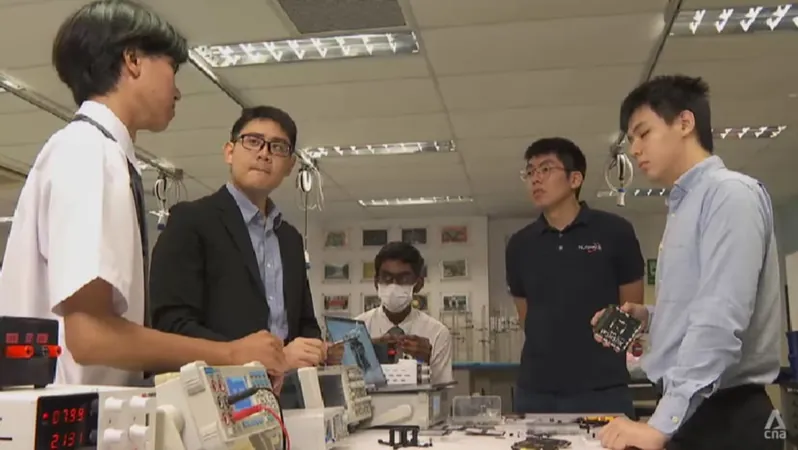
NUS High School Students Set to Launch First Nanosatellite into Space Next March
2024-12-31
Author: Mei
SINGAPORE:
In a groundbreaking achievement, students from the NUS High School of Mathematics and Science are set to launch their first-ever nanosatellite into space aboard a SpaceX rocket from Florida, USA, in March 2024. This pioneering project marks a significant milestone for high schoolers in Singapore and underscores a growing interest in space engineering among the youth.
Building the Nanosatellite
The origins of the project date back five years, stemming from a basic circuit board. Lin Yicheng, a former NUS High student who began work on the project at just 16 years old, has remained actively involved as a mentor to current students, guiding them in the intricacies of satellite technology. His incredible dedication and expertise include customizing the spacecraft’s image compressor using knowledge gleaned from NASA documents and reverse-engineering related software.
"Using NASA's algorithms, which are essential for long-distance communication like that with Mars rovers, allows us to ensure that even with data loss during transmission, we still have a chance of successfully retrieving images on Earth," said Lin, who is now 20 and fulfilling his National Service.
The construction of the nanosatellite involved an ambitious approach where students decided to design various components from scratch, including the vital circuit boards, to maximize their learning experiences and expand the satellite's capabilities. This hands-on involvement represents a unique educational opportunity unlike anything found in traditional curricula.
Challenges and Triumphs
For current student Vincent Kwok, 17, who joined the project two years ago, the experience has been transformative. "We've subjected our satellite to extreme environmental tests—cycling between 60 degrees Celsius to -20 degrees Celsius—to ensure it can withstand harsh conditions," Kwok explained.
Despite the myriad challenges, including changes in project personnel with each graduating class, Kwok shared that the dedication of all prior teams motivates them to succeed. “This is a culmination of efforts spanning five years. It feels surreal to be the team finalizing this project, and we want to honor all the hard work that came before us," he added.
The Nanosatellite's Design and Functionality
Weighing in at under 900 grams and measuring just 10 cm on each side, the nanosatellite exemplifies the innovative spirit of its young creators. Although nanosatellites are generally cheaper and lighter than traditional satellites, the challenge lies in fitting essential components into such a compact form. Featuring multiple circuit boards for power management, camera control, and communication, the satellite will compress images during transmission due to bandwidth limitations.
Once fully assembled and tested, the nanosatellite will be loaded into a specialized container designed to carry multiple satellites during launch. Following deployment, the team will attempt to establish contact with their satellite for the first time, a moment that promises to be filled with anticipation and excitement as they await the transmission of Earth images.
A New Era for Singapore's Space Aspirations
The initiative is not just an academic exercise; it plays a crucial role in fueling interest in Singapore's burgeoning space industry. According to Andre Jusuf, the team’s faculty mentor, fostering a passion for engineering and satellite technology is essential for the future workforce. Moreover, with the nation's aims to strengthen its position in the global space industry, mentorship from industry leaders like Mr. Ng Zhen Ning, CEO of NuSpace, further supports these students in their ventures.
“Engaging with students and providing them with real-world experiences is vital. We need to inspire future leaders in STEM (science, technology, engineering, and mathematics) fields to prevent a manpower shortage as the space industry grows,” said Mr. Ng.
For the bright minds at NUS High School, this nanosatellite marks only the beginning. They envision erecting even more ambitious projects ahead, including plans for a satellite three times the size of their current creation.
Conclusion
Stay tuned as we follow this exciting journey into space! Will Singapore’s young engineers inspire a new wave of space enthusiasts? The countdown is on!



 Brasil (PT)
Brasil (PT)
 Canada (EN)
Canada (EN)
 Chile (ES)
Chile (ES)
 Česko (CS)
Česko (CS)
 대한민국 (KO)
대한민국 (KO)
 España (ES)
España (ES)
 France (FR)
France (FR)
 Hong Kong (EN)
Hong Kong (EN)
 Italia (IT)
Italia (IT)
 日本 (JA)
日本 (JA)
 Magyarország (HU)
Magyarország (HU)
 Norge (NO)
Norge (NO)
 Polska (PL)
Polska (PL)
 Schweiz (DE)
Schweiz (DE)
 Singapore (EN)
Singapore (EN)
 Sverige (SV)
Sverige (SV)
 Suomi (FI)
Suomi (FI)
 Türkiye (TR)
Türkiye (TR)
 الإمارات العربية المتحدة (AR)
الإمارات العربية المتحدة (AR)